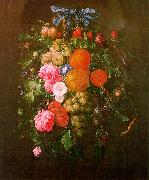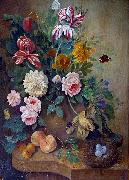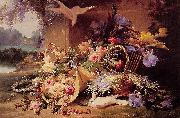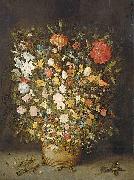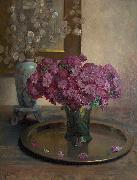Wholesale Oil Painting Reproductions No Minimum and Door to Door! |
|||||||||||
|
|
|||||||||||

|
|||||||||||
|
|
|
||||||||
All Cornelis de Heem Oil Paintings |
||||||||
|
|
||||||||
|
|
||||||||
|
Artist Introduction: Dutch Baroque Era Painter, 1631-1695
Son of Jan Davidsz. de Heem. He spent a great deal of his life in Antwerp, where he was taught by his father. Cornelis also worked in Utrecht in 1667, in nearby IJsselstein in 1676 and in The Hague from 1676 for more than ten years. His best works approach the quality of his father, particularly in works executed during the decade starting in 1655. Cornelis still-lifes can be distinguished by daring colour harmonies, sometimes with a strong blue. His compositions are often simpler: fruit-pieces, floral bouquets, festoons and garlands and sumptuous still-lifes, only occasionally in large formats. His technique changed from a more painterly to a more graphic style. |
||||||||
|
|
||||||||
|
Still Life with Flowers Painting ID:: 1591 |
1660 |
|||||||
Height Width |
INS/CM Quality |
|||||||
|
X |
| |||||||
|
|
||||||||
All unknow artist Oil Paintings |
||||||||
|
|
||||||||
|
|
||||||||
|
Artist Introduction: |
||||||||
|
|
||||||||
|
|
Still life with flowers Painting ID:: 67449 |
"Still life with flowers", oil painting by Joseph Nigg (1782-1863) |
||||||
Height Width |
INS/CM Quality |
|||||||
|
X |
| |||||||
|
|
||||||||
All Eugene Bidau Oil Paintings |
||||||||
|
|
||||||||
|
|
||||||||
|
Artist Introduction: French
19th Century
|
||||||||
|
|
||||||||
|
|
Still Life with Flowers Painting ID:: 70050 |
Medium Oil on canvas
Dimensions 91.4 x 119.4 cm
|
||||||
Height Width |
INS/CM Quality |
|||||||
|
X |
| |||||||
|
|
||||||||
All unknow artist Oil Paintings |
||||||||
|
|
||||||||
|
|
||||||||
|
Artist Introduction: |
||||||||
|
|
||||||||
|
|
Still Life with Flowers Painting ID:: 71623 |
Oil on panel
113.7 x 86.4 cm (44.76 x 34.02 in)
|
||||||
Height Width |
INS/CM Quality |
|||||||
|
X |
| |||||||
|
|
||||||||
All unknow artist Oil Paintings |
||||||||
|
|
||||||||
|
|
||||||||
|
Artist Introduction: |
||||||||
|
|
||||||||
|
|
Still Life with Flowers Painting ID:: 72806 |
Medium Oil on panel
Dimensions 113.7 X 86.4 cm (44.76 X 34.02 in)
cyf |
||||||
Height Width |
INS/CM Quality |
|||||||
|
X |
| |||||||
|
|
||||||||
All Georges Jansoone Oil Paintings |
||||||||
|
|
||||||||
|
|
||||||||
|
Artist Introduction: George Jamesone (or Jameson) (c. 1587-1644) was Scotland's first eminent portrait-painter.
He was born in Aberdeen, where his father, Andrew Jamesone, was a stonemason. Jamesone attended the grammar school near his home on Schoolhill and is thought to have gone on to further education at Marischal College. Legend has it that Jamesone once studied under Rubens in Antwerp with Anthony van Dyck. However, this is yet to be proven as his name does not appear to be noted in the Guild registers of the town. However, considering that Rubens was exempt from registering pupils; this does not mean that the painter definitely did not study there. Jamesone certainly did complete an apprenticeship under the supervision of his uncle, John Anderson, who was a popular decorative painter in Edinburgh at the beginning of the seventeenth century. Jamesone finished this training in 1618. He is not recorded as being in Aberdeen again until 1620. If the Scotsman had gone to Antwerp, it would have had to have been between the years of 1618 to 1620. |
||||||||
|
|
||||||||
|
|
Still life with flowers Painting ID:: 75624 |
Still life with flowers", oil painting on canvas (70 x 60 cm) by Julien 't Felt (1874-1933); private collection
cyf |
||||||
Height Width |
INS/CM Quality |
|||||||
|
X |
| |||||||
|
|
||||||||
All Anna Munthe-Norstedt Oil Paintings |
||||||||
|
|
||||||||
|
|
||||||||
|
Artist Introduction: painted Still Life with Spring Flowers in 1892 |
||||||||
|
|
||||||||
|
|
Still Life with Flowers Painting ID:: 82216 |
Date 1896(1896)
Medium Oil on panel
Dimensions 22 x 13 cm (8.7 x 5.1 in)
cjr |
||||||
Height Width |
INS/CM Quality |
|||||||
|
X |
| |||||||
|
|
||||||||
All Anna Munthe-Norstedt Oil Paintings |
||||||||
|
|
||||||||
|
|
||||||||
|
Artist Introduction: painted Still Life with Spring Flowers in 1892 |
||||||||
|
|
||||||||
|
|
Still Life with Flowers Painting ID:: 96580 |
1896(1896)
Medium oil on panel
Dimensions 22 X 13 cm
cyf |
||||||
Height Width |
INS/CM Quality |
|||||||
|
X |
| |||||||
|
|
||||||||
|
Prev Next
|
||||||||
|
|
||||||||
|
Related Paintings to Anna Munthe-Norstedt :. |
||||||||
|
|
||||||||
|
CONTACT US |
